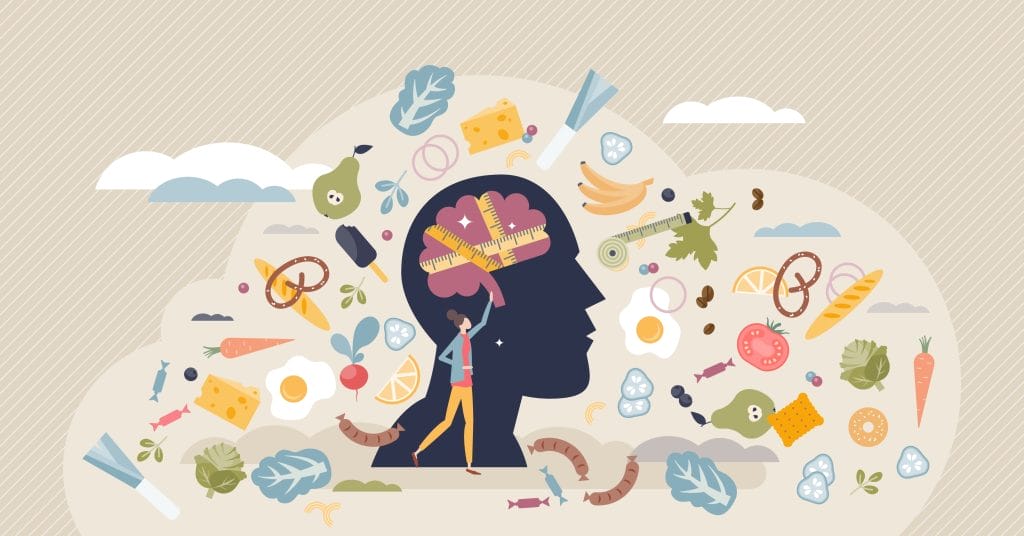Disclaimer/TW: The following article discusses eating disorders and body image in detail, which may be triggering for some.
Recent years have seen a significant cultural shift towards body positivity and acceptance, but there still remains plenty of work to be done.
Though certain eating disorders, such as binge eating, may be shamed, others—restrictive eating disorders—are glamorized. This poses a risk for the growing base of young Internet users.
The Beginnings of “Pro-Ana”
One of the original bastions of ED-based online communities was “pro-ana” (pro-anorexia) Tumblr in the early 2000s.
By 2012, pro-anorexia and bulimia content had become so prevalent that the site enacted policy changes banning blogs with this content and other content that seemed to promote self-harm.
Tumblr’s format allows users to form specially curated spaces around a certain interest. As a result, most pro-ED posts were limited to self-contained, niche online communities. Today, they seem to be making a reemergence on more mainstream platforms.
The Covert Reappearance of Pro-Ana
While Tumblr’s pro-ana days have seemingly passed, it has been reborn on more mainstream platforms like TikTok under the guise of self-care.
In an interview with Nylon, TikTok user Devany Sparrow said,
The main difference is how much more covert TikTok is about it compared to Tumblr. It’s all disguised as wellness or being healthy. It’s much more difficult for me to differentiate what’s taking care of my body and what’s my eating disorder trying to creep back into my world.”
Devany Sparrow
With many social media platforms having taken steps towards monitoring, removing, and censoring pro-ED content, users have responded with a pretense of “healthy eating” to justify miniscule portions and calorie-counting. Photos and videos also include the benefit of carefully chosen filters and edits to soften the effect of its worrisome content.
Weight Loss As Aesthetic
Before looking at the current reigning social media giant, TikTok, one site that has existed since Tumblr’s pro-ana days and continues to survive with a new Gen Z audience is Pinterest.
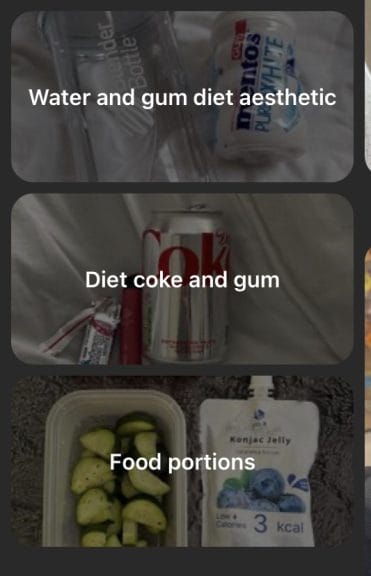
People use Pinterest to collect images for inspiration. As Amanda Hoover discusses in an article on Wired, the site has seen rising popularity among Gen Z users, who see it as relatively safe from the expectations of other social media like Instagram and Twitter/X.
“People can use Pinterest to find inspiration…without having to show themselves living out all those aspirational, and often expensive, trends, or images of their faces and bodies.”
Amanda Hoover
But while it may generally lack the pressure of likes and followers, Pinterest—an image-based platform—is still a space reliant on aesthetics. And where there is aesthetic, there is the pressure of expectations.
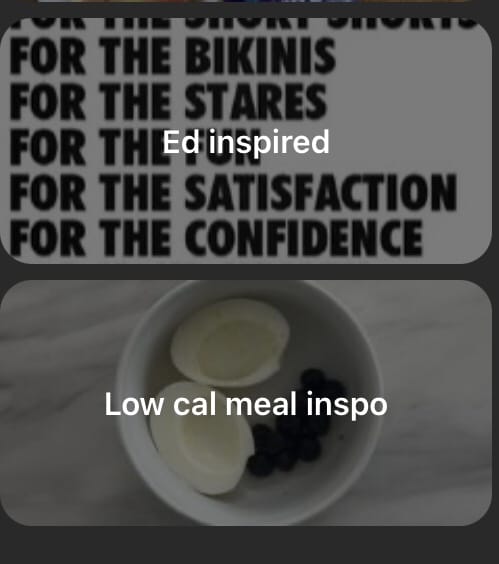
One use of Pinterest is to search for healthy recipes. Unfortunately, searching for “healthy” quickly leads to an unfortunate spiral of posts promoting weight loss. Plates of hard-boiled eggs and rice cakes, articles on how to lose 30 pounds on a liquid diet, collages of salad bowls and feet on a scale.
It’s not about health. It’s about striving towards a nearly impossible standard.
Search Censorship: Helpful Deterrent or Mere Diversion?
Like 2012 Tumblr, Pinterest moved to ban weight loss-related ads on its platform in 2021, a first among major online social networks.
Though removing weight loss ads was an important move, today many posts and comments on the site continue to slip under the radar.
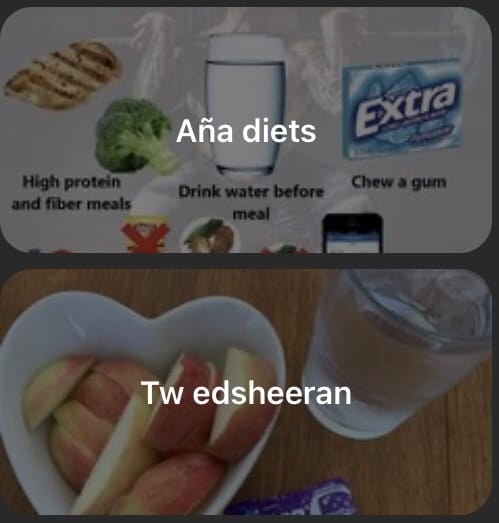
Though ads may be banned, the site still allows posts and searches on weight loss—as long as you abbreviate it to “wl.”
If you like to browse recipes and images of food on Pinterest, it probably won’t take long for the site to start suggesting searches for things like “minimal eating” or “skinnytaste,” with the space between words removed, of course, to evade filters.
You may even see suggested searches using singer-songwriter Ed Sheeran’s name as a coverup.
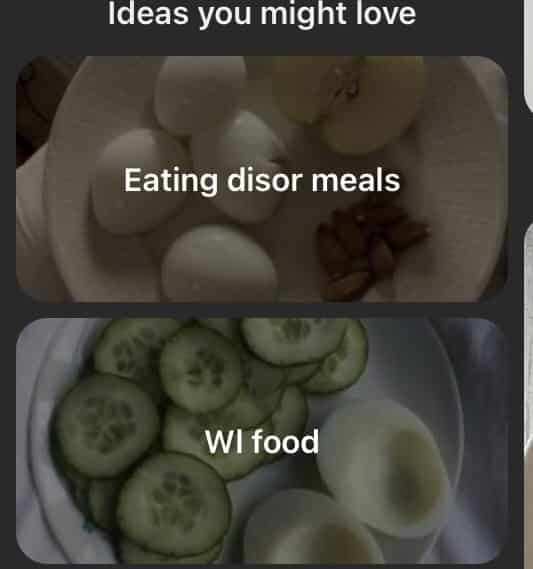
With its massive influence among Gen Z, perhaps the most concerning instance of the reemergence of pro-ed content is on TikTok.
Just like on Pinterest, on paper, TikTok does not promote weight-loss or eating disorder content. But in 2021, The Guardian found that this content remained searchable through censored or seemingly innocuous tags like #caloriedeficitsnacks, or #thinspao in place of the banned #thinspiration.
Also like Pinterest, TikTok has seen its own share of aestheticized diet content that seems more focused on creating an image than promoting health. Compared to Pinterest, too, TikTok has a significantly larger user base and influence, especially among Gen Z, raising concerns on how posts may negatively influence young people’s self-esteem and relationships with food.
WIEIAD: Dangerous Comparisons
One genre of videos that has seen popularity on TikTok, YouTube, and Instagram are “WIEIAD” or “What I eat in a day” videos.
Some may see these kinds of videos as harmless entertainment. It can be entertaining to admire aesthetic-looking foods. Some use the videos as inspiration for their own meal prep.
While there may be plenty of innocent, healthy uses of such content, these videos do not come without concerns. Perhaps most notable is the lack of transparency.
A 2023 article from the Student Wellness Centre of McMaster University discusses the potential harmful effects of WIEIADs:
It is super important to remember these videos are a single day, in one person’s life, and are often curated to fit a certain image.”
Student Wellness Centre of McMaster University
These videos are purposefully recorded and edited to share with and be appealing to audiences. Whether one admits to it, whenever you share a part of yourself online, you choose an image to present. Entertainment is often the priority. As a result, these videos can present dishonest and unrealistic portrayals of eating habits.
WIEIAD: More Than Just Food
A particularly dangerous feature of WIEIAD videos is the inclusion of body checks: scale measurements, mirror selfies of appealing outfits exposing a toned or hourglass stomach. When a WIEIAD includes “body checking,” it becomes more than just a fun food video. These checks explicitly feed into the idea that a certain diet guarantees a certain body.
As Anaïs Wyder describes the WIEIAD trend in an article on Trill,
“While it may disguise itself as a simple look into someone’s eating habits, it [more closely] resembles idolization and a toxic attempt at looking like a celebrity rather than feeling good in one’s skin.”
Anais Wyder
But you don’t even need to be a celebrity to promote an image.
Even without body checks, accompanying these videos may be titles like “WIEIAD as a model” or “WIEIAD as a healthy girl.” The creator portrays themselves as an example of what “healthy” looks like, and “healthy” becomes yet another brand of “___ girl.” These types of WIEIADs are perhaps some of the more obvious in the (likely unintentional) promotion of restrictive EDs.
“The suggestion that a healthy relationship with food is only for those who are of a certain weight, fitness level, or societal beauty standard is not only untrue but potentially damaging to viewers’ self-esteem.”
McMaster University
It’s not about health. It’s about striving for an idealized, often impossible image.
WIEIAD: Coping or Cycling?
While one should take caution when speculating about strangers’ health, it’s not a far leap of logic to consider that these influencers may experience disordered eating themselves. Searching “wieiad” on YouTube will yield videos that may include “tw ed” in their titles.
Some creators may just want to be open about their struggles. In fact, the hashtag #recoverywieaid specifically follows creators sharing their recovery journeys. For them, WIEIAD can be a tool to help mend one’s relationship with food.
At the same time, some videos create an echo chamber. Eating disorders are acknowledged but unaddressed. Additionally, despite videos that are self-aware enough to include trigger warnings for eating disorders, the vast majority of WIEIADs present themselves in a lens of complete normality.
WIEIAD: The Burden Of Influence
One may pass the responsibility to the viewer to not take ED WIEADs as advice. It’s am important reminder, but oftentimes, a WIEAD video is just the last straw on a camel’s back of beauty standards.
Most of these videos continue to perpetuate dangerous narratives. Body checks, titles, and captions at best normalize the pursuit of skinniness and at worst, promote restrictive eating to achieve it. Audiences that like and follow creators of these videos can easily fall into the dangerous mindset of comparison, a danger which these videos tend to largely ignore.
Moving Towards Body Positivity and Neutrality
The effect of social media on young people’s mental health and body image has long been a point of concern. A 2016 study, found a correlation between social media use and disordered eating behaviors. And as our lives become increasingly more digital, it is important to be critical of what we normalize.
There has certainly still been progress in promoting body positivity and neutrality. Social media ought to continue making policy changes in this direction, and the aestheticized ideals of WIEADs may be reframed into celebrations of food, recovery, and self-worth.
If you or someone you know is struggling with disordered eating, please reach out.
United States:
The Alliance for Eating Disorders Awareness Helpline: 1-866-662-1235
Substance Abuse and Mental Health Services Administration National Helpline: 1-800-662-4357
United Kingdom:
Beat Eating Disorders Helpline: 0808-801-0677 (England), 0808-801-0432 (Scotland), 0808-801-0433 (Wales)


